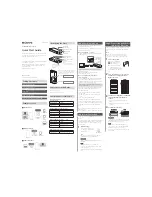
14628 Central Blvd,
Chino, CA91710
tel:909.597.7588, fax:909.597.1939
© Copyright 2011 Acnodes, Inc.
All rights reserved. Product description and product specifications
are subject to change without notice. For latest product information,
please visit Acnodes’ web site at www.acnodes.com.
RMC 7150
14” short depth rack server
41
6-2
Control Panel
The control panel (located on the front of the chassis) must be connected to the JF1 connector on the serverboard to provide
you with system control buttons and status indicators. These wires have been bundled together in a ribbon cable to simplify the
connection.
Connect the cable from JF1 on the serverboard to the Control Panel PCB (printed circuit board). Make sure the red wire plugs
into pin 1 on both connectors. Pull all excess cabling out of the airflow path.
The LEDs inform you of system status. See Chapter 3 for details on the LEDs and the control panel buttons. Details on JF1
can be found in Chapter 5.
6-3
System Fans
It employs three sets of 4-cm counter-rotating fans to provide cooling. Each fan unit is made up of two fans joined back-to-back,
which rotate in opposite directions. This counter-rotating action generates exceptional airflow and works to dampen vibration
levels. The fans can adjust their speed according to the heat level sensed in the system, which results in more efficient and
quieter fan operation. Fan speed is controlled by a setting in BIOS (see Chapter 7). Each fan in a set has its own separate
tachometer.
Note: It is very important that the chassis top cover is properly installed for the airflow to circulate properly through the chassis
and cool the components.
System Fan Failure
If a fan fails, the remaining fans will ramp up to full speed and the overheat/fan fail LED on the control panel will blink on and off.
Replace any failed fan at your earliest convenience with the same type and model (the system can continue to run with a failed
fan).
Replacing System Fans (Figure 6-2)
1. Remove the chassis cover to see which fan has failed.
2. Power down the server and remove the AC power cord.
3. Detach the fan wiring then grasp the failed fan unit and lift it out of the chas- sis.
4. Replace the failed fan with an identical 4-cm, 12 volt fan (see Appendix C).
5. Push the new fan into the vacant space in the housing making sure the ar- rows on the top of the fan (indicating air direc-
tion) point in the same direction as the arrows on the other fans.
6. Reposition the fan housing back over the two mounting posts in the chassis, then reconnect the fan wires to the same
chassis fan headers you removed them from.
7. Power up the system and check that the fan is working properly and that the LED on the control panel has turned off.
Finish by replacing the chassis cover.
















































